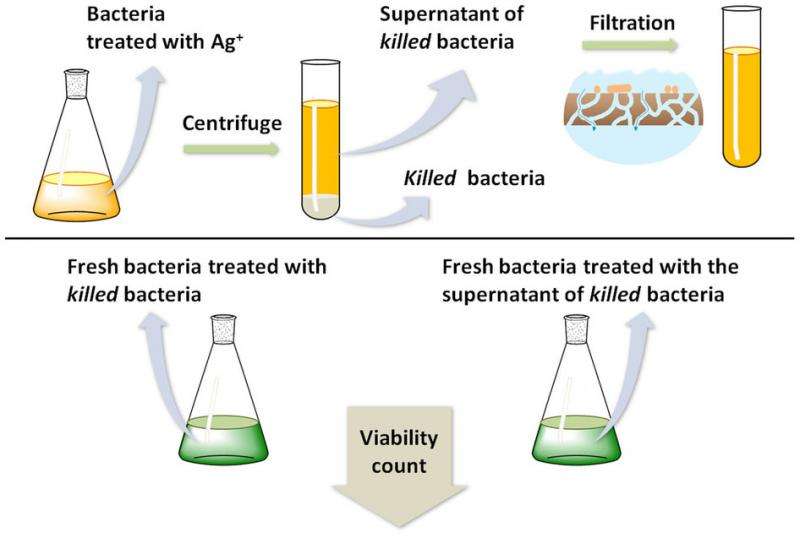May 4, 2015 report
'Zombie' bacteria found able to kill other bacteria

(Phys.org)—A trio of researchers with the Hebrew University of Jerusalem has found that bacteria that die as a result of silver poisoning can serve as a means to continue to kill other bacteria in the same environment. In their paper published in the journal Scientific Reports, the team describes how examination of dead bacteria revealed the silver that remained trapped inside of them and how it later caused the death of other bacteria.
People have been using silver to kill bacteria for thousands of years, but only in a direct way. In this latest effort, the researchers found that because silver ions poke holes in bacterial membranes and make their way inside, those that die serve as a sort of bank, holding onto silver reserves. But as time passes and the dead bacteria decay, the silver inside of them escapes into the environment around them, and if that environment has other bacteria in it, they are killed as well.
The team found this out by placing bacteria specimens in a solution containing bits of silver, then after the bacteria died, they pulled them from the solution and examined them under an electron microscope—they were able to see the bits of silver speckling the insides of an individual bacterium. Next, they put some dead individuals into a clean solution seeded with fresh bacteria and found that silver inside of it was released into the solution killing 99.99 percent of the bacteria—the team calls it the zombie effect. After their discovery they initiated several tests to determine the killing power of the solution polluted with the dead bacteria—they found that an initial low concentration was not enough to kill all of a third batch of bacteria, which indicated that the bacteria that had been killed by the remains of the first batch of bacteria, had soaked up by the silver—it was only after they decayed that the third batch was killed—thus it appears that the killing ability of the solution could conceivably carry on indefinitely as those that die, slowly release the silver inside them.
As the team explains, the bacteria are like sponges, soaking up silver, then releasing it after they die, causing it to be soaked up by other bacteria, and on and on. This, means, the researchers suggest, that methods of using silver as an antibacterial agent, might benefit from modification, allowing for an increase in longevity.
More information: Antibacterial activity of silver-killed bacteria: the "zombies" effect, Scientific Reports 5, Article number: 9555 DOI: 10.1038/srep09555
Abstract
We report a previously unrecognized mechanism for the prolonged action of biocidal agents, which we denote as the zombies effect: biocidally-killed bacteria are capable of killing living bacteria. The concept is demonstrated by first killing Pseudomonas aeruginosa PAO1 with silver nitrate and then challenging, with the dead bacteria, a viable culture of the same bacterium: Efficient antibacterial activity of the killed bacteria is observed. A mechanism is suggested in terms of the action of the dead bacteria as a reservoir of silver, which, due to Le-Chatelier's principle, is re-targeted to the living bacteria. Langmuirian behavior, as well as deviations from it, support the proposed mechanism.
Journal information: Scientific Reports
© 2015 Phys.org


















